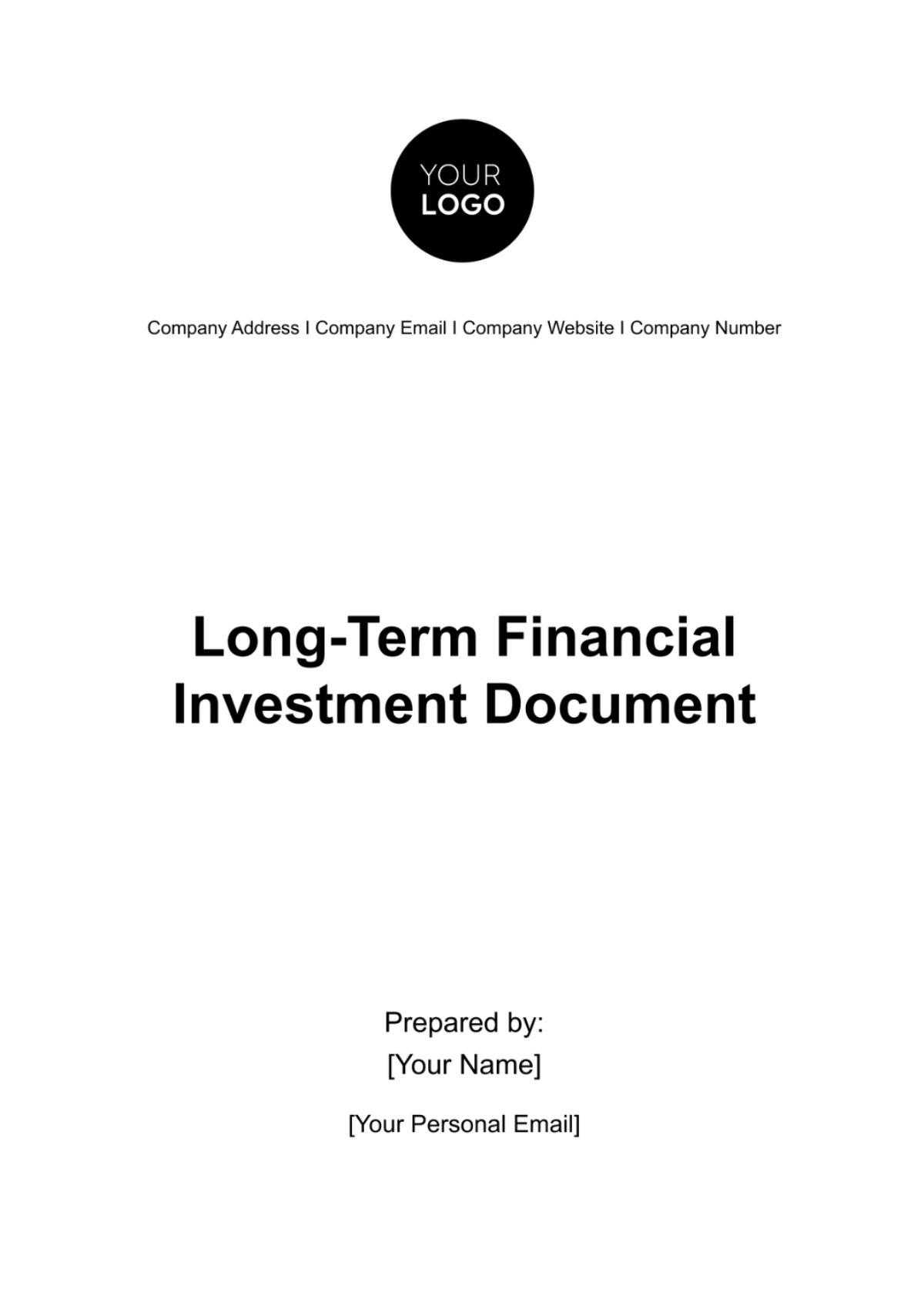Free Long-Term Financial Investment Document

I. Executive Summary
Overview of Investment Philosophy
Our investment philosophy is anchored in the pursuit of long-term capital growth, complemented by a commitment to prudent risk management. We adhere to a patient and disciplined approach, meticulously selecting high-quality assets that offer prospects for sustainable growth and demonstrate resilience across varying market conditions. This philosophy is rooted in a deep understanding of market dynamics and a steadfast focus on long-term value creation, rather than short-term market fluctuations. By prioritizing assets with strong fundamentals and growth potential, we aim to build a robust investment portfolio that can weather market uncertainties and capitalize on growth opportunities.
Long-Term Financial Goals
The cornerstone of our financial strategy is to achieve significant growth over a 10-20 year horizon. Our primary objective is to attain an annual return rate that not only consistently outpaces inflation but also surpasses average market returns. This ambitious goal is set with a vision to maximize wealth creation for our clients, ensuring that their investments significantly appreciate in value over the long term. We understand that achieving these goals requires a strategic blend of patience, market insight, and the ability to capitalize on compounding returns, all while effectively managing risks.
Summary of Investment Strategy
Our investment strategy is meticulously crafted to align with our long-term growth objectives. It revolves around constructing a diversified portfolio that spans a range of asset classes, including equities, fixed-income securities, real estate, and potentially alternative investments. This diversification is crucial for balancing risk and optimizing returns. We employ regular portfolio rebalancing to maintain alignment with our strategic asset allocation, ensuring that our investments are responsive to and in tune with evolving market conditions and economic indicators. This dynamic approach allows us to adapt to market changes proactively, positioning the portfolio to capitalize on opportunities and mitigate risks effectively.
II. Market Analysis and Economic Outlook
This section offers a comprehensive analysis of current market conditions, provides long-term economic forecasts, and assesses the impact of these trends on investment strategies. It's a crucial guide for understanding how various economic factors influence investment decisions and for anticipating future market movements.
A. Overview of Current Market Conditions
We analyze current market trends, including interest rates, inflation, and global economic indicators, to understand their impact on different asset classes.
Market Factor | Current Status | Impact on Asset Classes |
Interest Rates | [Current Rate]% | Affects bond yields and borrowing costs, influencing fixed-income and equity markets. |
Inflation Rate | [Current Rate]% | Impacts purchasing power, affecting consumer spending and investment returns. |
Global Economic Indicators | [e.g., GDP Growth, Unemployment Rates] | Provide insights into the health of major economies, influencing global investment trends. |
B. Long-Term Economic Forecasts
The document includes projections on economic growth, potential market disruptors, and emerging trends that could influence investment decisions over the next two decades.
Economic Aspect | Forecast | Potential Impact on Markets |
Economic Growth | [Projected Growth]% | Influences corporate earnings and investment opportunities in growth sectors. |
Market Disruptors | [e.g., Technological Innovations, Policy Changes] | Could significantly alter market landscapes and create new investment opportunities or risks. |
Emerging Trends | [e.g., Demographic Shifts, Environmental Concerns] | May shift investor focus towards sustainable and socially responsible investments. |
C. Impact of Economic Trends on Investments
This section elaborates on how identified economic trends could impact our investment approach, including potential opportunities and risks.
Economic Trend | Potential Opportunity | Potential Risk |
Rising Interest Rates | Benefits for fixed-income investments with higher yields. | Potential decrease in the value of existing bonds; increased cost of borrowing for companies. |
Inflationary Trends | Opportunities in commodities and real assets which tend to perform well during inflation. | Erosion of purchasing power and real returns for cash and fixed-income assets. |
Global Economic Shifts | Emerging markets could present growth opportunities. | Geopolitical tensions or trade disputes could negatively impact international investments. |
III. Asset Allocation and Investment Strategy
This section delves into the strategic approach of asset allocation and diversification tailored for long-term growth. It discusses how assets are allocated across different classes, the importance of diversification, and the meticulous process of selecting individual investments to ensure a stable and prosperous investment portfolio.
A. Asset Allocation Principles for Long-Term Growth
Our asset allocation is designed to optimize long-term growth while managing risk. We allocate investments across a spectrum of asset classes including stocks for growth potential, bonds for income and stability, real estate for diversification and inflation protection, and alternative investments for unique growth opportunities and further diversification. This balanced approach is crucial for smoothing out market volatility over time and achieving steady growth. Our allocation percentages are carefully calibrated based on current market analyses, economic forecasts, and our clients' individual goals and risk tolerances.
B. Diversification Strategy Across Asset Classes
Diversification is a key strategy in our investment approach. We don't just diversify across traditional asset classes; we also ensure geographical diversification to mitigate the risks associated with specific regional markets. Additionally, we diversify across various sectors and industries, reducing the portfolio's vulnerability to sector-specific downturns. This broad diversification helps in cushioning the portfolio against market fluctuations and economic downturns, providing a more stable growth trajectory over the long term.
C. Approach to Selecting Individual Investments
The selection of individual investments is a meticulous process that hinges on a thorough analysis of fundamentals, including company financials, management quality, market position, and potential for growth. We also evaluate macroeconomic factors and industry trends to identify investments with strong long-term prospects. Risk factors are carefully weighed to ensure alignment with the overall investment strategy and risk profile. Our focus remains steadfast on identifying assets with the potential for stable and sustained performance over the long term.
IV. Risk Management and Mitigation Strategies
This section is dedicated to identifying key long-term risks in investments and outlining comprehensive strategies to mitigate these risks. It also describes approaches to managing market volatility, ensuring a stable investment journey. The focus is on proactive risk management to safeguard investments against potential adverse market conditions.
A. Identification of Potential Long-Term Risks
This includes market risk, interest rate risk, inflation risk, and geopolitical risks, among others.
Risk Type | Description |
Market Risk | The risk of losses due to factors that affect the overall performance of financial markets. |
Interest Rate Risk | Risk of fluctuating interest rates affecting investment value, particularly in bonds. |
Inflation Risk | The possibility that inflation will erode the purchasing power of returns. |
Geopolitical Risk | The risk arising from political instability or changes in government policy affecting investments. |
Currency Risk | Risk of loss from unfavorable movements in exchange rates in foreign investments. |
B. Strategies for Mitigating Various Investment Risks
We use strategies such as asset diversification, hedging, and the use of fixed-income instruments to mitigate these risks.
Mitigation Strategy | Description |
Diversification | Spreading investments across various asset classes and geographies to reduce exposure to any single risk. |
Hedging | Using derivatives to offset potential losses in investments. |
Fixed-Income Instruments | Investing in bonds and other fixed-income securities to provide stable income and reduce volatility. |
Asset Allocation | Allocating assets in a manner that balances risk and return, suited to the investor’s risk profile. |
Regular Portfolio Review | Periodically reviewing and adjusting the portfolio to respond to changing market conditions and risks. |
C. Approach to Managing Market Volatility
The document details our approach to managing short-term market volatility, emphasizing a long-term view and avoiding reactionary decisions.
Approach | Description |
Long-Term Perspective | Focusing on long-term investment goals rather than reacting to short-term market fluctuations. |
Dollar-Cost Averaging | Investing a fixed amount regularly, regardless of market conditions, to reduce the impact of volatility. |
Quality Investments | Selecting investments with strong fundamentals likely to perform well over the long term. |
Market Research | Continuously researching market trends and economic indicators to inform investment decisions. |
Stress Testing | Periodically testing the portfolio against extreme market scenarios to assess its resilience. |
V. Performance Monitoring and Review Procedures
This section outlines the systematic approach we take in tracking, reviewing, and adjusting our investment strategies to ensure they align with our long-term objectives and adapt to changing market conditions.
A. Methods for Tracking Investment Performance
We adopt a rigorous approach to monitor investment performance, utilizing a combination of benchmark indices and a suite of performance metrics. Our methodology includes comparing portfolio returns against relevant market indices to gauge relative performance. Additionally, we use metrics like alpha, beta, and Sharpe ratio to understand risk-adjusted returns and volatility. This holistic approach ensures a comprehensive view of our investments' performance, enabling us to make data-driven decisions and maintain alignment with our investment goals.
B. Frequency and Format of Performance Reviews
Our portfolios undergo a thorough review semi-annually. These reviews are meticulously documented in comprehensive reports that provide a deep dive into the portfolio's performance, including analyses of returns, comparison with benchmarks, and an overview of market changes during the period. The reports also detail any adjustments or rebalancing actions taken. This regular and structured review process is vital for keeping our investment strategies on track and ensuring transparency with our investors.
C. Criteria for Adjusting Investment Strategies
Adjustments to our investment strategies are considered under several key circumstances: significant market changes, economic shifts, and changes in the investor's financial situation or risk tolerance. This could include a major market correction, a shift in monetary policy, or personal life events affecting the investor's financial goals. Our approach is proactive and responsive, ensuring that our investment strategies remain relevant, resilient, and aligned with both the current market environment and our investors' evolving needs.
- 100% Customizable, free editor
- Access 1 Million+ Templates, photo’s & graphics
- Download or share as a template
- Click and replace photos, graphics, text, backgrounds
- Resize, crop, AI write & more
- Access advanced editor
Elevate your financial strategy with Template.net's Long-Term Financial Investment Document. This editable, fully customizable tool is designed for effortless precision. Fine-tuned with our Ai Editor Tool, it ensures comprehensive financial mapping. Its interactive components inspire confident decision-making. Experience engaging, professional-grade financial organization. Plan your financial journey today.





























